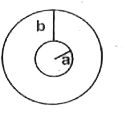A coil develops heat of 800 cal / sec . When 20 volts is applied across its ends. The resistance of the coil is (1 cal = 4.2 joule )
1.2Ω
1.4Ω
0.12Ω
0.14Ω
The correct Answer is:C
To find the resistance of the coil, we can follow these steps:
Step 1: Convert the heat developed from calories to joules.
The coil develops heat at a rate of 800 cal/sec. We know that 1 cal = 4.2 joules.
Power (P)=800cal/sec×4.2joules/cal=3360joules/sec
Step 2: Use the formula for electrical power.
The power developed in an electrical circuit can also be expressed as:
P=V2R
Where:
- P is the power in watts (joules/sec),
- V is the voltage in volts,
- R is the resistance in ohms.
Step 3: Rearrange the formula to solve for resistance.
Rearranging the formula gives us:
R=V2P
Step 4: Substitute the known values into the equation.
We know V=20volts and P=3360joules/sec.
R=2023360
Calculating 202:
202=400
Now substituting back into the equation:
R=4003360
Step 5: Simplify the fraction.
To simplify 4003360:
R=400÷803360÷80=542
Step 6: Calculate the numerical value.
Now we calculate 542:
R≈0.119ohms
Step 7: Round to two decimal places.
Rounding 0.119 gives us:
R≈0.12ohms
Final Answer:
The resistance of the coil is approximately 0.12 ohms.
---
The coil develops heat at a rate of 800 cal/sec. We know that 1 cal = 4.2 joules.
The power developed in an electrical circuit can also be expressed as:
- P is the power in watts (joules/sec),
- V is the voltage in volts,
- R is the resistance in ohms.
Rearranging the formula gives us:
We know V=20volts and P=3360joules/sec.
To simplify 4003360:
Now we calculate 542:
Rounding 0.119 gives us:
The resistance of the coil is approximately 0.12 ohms.
Topper's Solved these Questions
- HEATING AND CHEMICAL EFFECT OF CURRENTBook:ERRORLESS Chapter:HEATING AND CHEMICAL EFFECT OF CURRENTExercise:Heating Effect of Current
Explore 2 Videos
- HEATING AND CHEMICAL EFFECT OF CURRENTBook:ERRORLESS Chapter:HEATING AND CHEMICAL EFFECT OF CURRENTExercise:Chemical Effect Current
Explore 1 Video
- ELECTROSTATICS Book:ERRORLESS Chapter:ELECTROSTATICS Exercise:Ordinary Thinking Objective Questions (Electric Flux and Gauss.s Law)
Explore 28 Videos
- KINETIC THEORY OF GASESBook:ERRORLESS Chapter:KINETIC THEORY OF GASESExercise:QUESTIONS
Explore 126 Videos
Similar Questions
A potential difference of 20 volts is applied across the ends of a resistance of 5 ohms. What current will flow in the resistance?
View SolutionThe current in the inner coil is I=2t2. Find the heat developed in the outer coil between t =0 and t seconds. The resistance of the outer coil is R and take b>>a.

View Solution
Knowledge Check
When 100 volt d.c. is applied across a solenoid, a current of 1.0 A flows in it. When 100 volt a.c. is applied across the same coil, the current drops to 0.5 A. If the frequency of a.c. source is 50 Hz the impedance and inductance of the solenoid is
A200Ωand0.55HB100Ωand0.86HC200Ωand1.0HD100Ωand0.93HMagnetic field changes at the rate of 0.4T/sec . In a squre coil of side 4 cm . Kept prependicular to the field. If the resistance of the coil is 2×10−3Ω , then induced current in coil is :-
A0.16B0.32C3.2D1.6A coil of water of resistance 50Ω is embedded in a block of ice and a potential difference of 210 V is applied across it. The amount of ice which melts in 1 second is [ latent heat of fusion of ice =80calg−1]
A0.262gB2.62gC26.2gD0.0262g
Calculate the heat generated in joule in a coil when potential difference of 30 volts is applied across it. The current of 0.8 A is passed for 4 minutes.
View SolutionCalculate the heat generated in joule in a coil when potential difference of 30 volts is applied across it. The current of 0.8 A is passed for 2 minutes.
View SolutionA potential difference of 250 volts is applied across a resistance of 500 ohms in an electric iron. Calculate (i) current, and (ii) heat energy produced in joules in 10 seconds.
View SolutionWhen 100V dc is applied across a coil a current of 1 A flows through it When 100V ac of 50Hz is applied across the same coil only 0.5A flows The resistance and inductance of the coil are (takeπ2=10) .
View SolutionAs a metal filament gets heated, its resistance increases. When a potential difference of 100 volts is applied across a filament bulb, the current flowing through it is found to be 0.4 A. When a potential difference of 200 volts is applied across the same bulb, it glows more. The current in the bulb can be expected to be expected to be
View Solution
